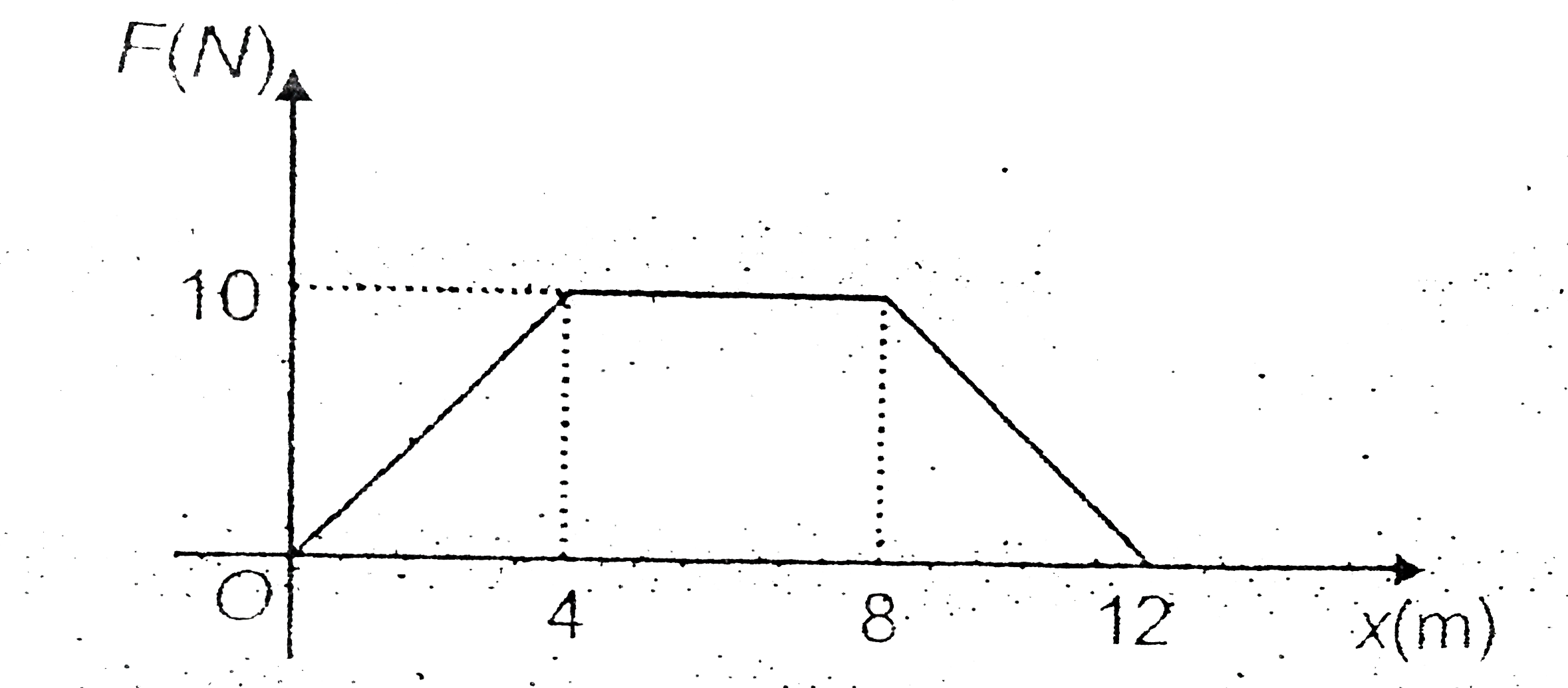A body of mass travels in a straight line with velocity where . The work done by the net force during its displacement from to is
1.5 J
50 J
10 J
100 J
The correct Answer is:B
To solve the problem of calculating the work done by the net force on a body of mass 0.5kg traveling with a velocity given by v=ax3/2 (where a=5m/s2) during its displacement from x=0 to x=2m, we can follow these steps:
Step 1: Determine the expression for velocity
The velocity of the body is given as:
v=ax3/2
Substituting the value of a:
v=5x3/2
Step 2: Find the acceleration
Acceleration a0 can be expressed as:
a0=dvdt
Using the chain rule:
a0=dvdx⋅dxdt=vdvdx
Now, we need to differentiate v with respect to x:
dvdx=ddx(5x3/2)=5⋅32x1/2=152x1/2
Thus, substituting back:
a0=v⋅dvdx=(5x3/2)⋅(152x1/2)=752x2
Step 3: Calculate the force
Using Newton's second law, the force F can be calculated as:
F=ma0
Substituting the mass m=0.5kg:
F=0.5⋅752x2=754x2
Step 4: Calculate the work done
The work done W by the net force during the displacement from x=0 to x=2 is given by the integral:
W=∫20Fdx=∫20(754x2)dx
Calculating the integral:
W=754∫20x2dx=754(x33)20=754⋅233=754⋅83=60012=50J
Final Answer
The work done by the net force during the displacement from x=0 to x=2m is:
50J
The velocity of the body is given as:
v=ax3/2
Substituting the value of a:
v=5x3/2
Acceleration a0 can be expressed as:
a0=dvdt
Using the chain rule:
a0=dvdx⋅dxdt=vdvdx
Now, we need to differentiate v with respect to x:
dvdx=ddx(5x3/2)=5⋅32x1/2=152x1/2
Thus, substituting back:
a0=v⋅dvdx=(5x3/2)⋅(152x1/2)=752x2
Using Newton's second law, the force F can be calculated as:
F=ma0
Substituting the mass m=0.5kg:
F=0.5⋅752x2=754x2
The work done W by the net force during the displacement from x=0 to x=2 is given by the integral:
W=∫20Fdx=∫20(754x2)dx
Calculating the integral:
W=754∫20x2dx=754(x33)20=754⋅233=754⋅83=60012=50J
The work done by the net force during the displacement from x=0 to x=2m is:
50J
Topper's Solved these Questions
- WORK, ENERGY AND POWERBOOK - DC PANDEY ENGLISHCHAPTER - WORK, ENERGY AND POWEREXERCISE - MEDICAL ENTRANCE SPECIAL QUESTIONS
16 Videos
- WORK, ENERGY AND POWERBOOK - DC PANDEY ENGLISHCHAPTER - WORK, ENERGY AND POWEREXERCISE - MATCH THE COLUMNS
7 Videos
- WORK, ENERGY AND POWERBOOK - DC PANDEY ENGLISHCHAPTER - WORK, ENERGY AND POWEREXERCISE - CHECK POINT 6.3
10 Videos
- WORK, ENERGY & POWERBOOK - DC PANDEY ENGLISHCHAPTER - WORK, ENERGY & POWEREXERCISE - Level 2 Comprehension Based
2 Videos
- WORK, POWER AND ENERGYBOOK - DC PANDEY ENGLISHCHAPTER - WORK, POWER AND ENERGYEXERCISE - E Integer Type Questions
11 Videos
Similar Questions
A particle of mass 0.5kg travels in a straight line with velocity v=ax3/2 where a=5m−1/2s−1. What is the work done by the net force during its displacement from x=0 to x=2m?
View SolutionA particle of mass 0.5kg travels in a straight line with velocity v=ax3/2 where a=5m−1/2s−1. What is the work done by the net force during its displacement from x=0 to x=2m?
View Solution
Knowledge Check
A body of mass 0.5 kg travels in a straight line with velocity v=kx3/2 where k=5m−1/2s−1. The work done by the net force during its displacement from x=0 to x=2 m is
A1.5 JB50 JC10 JD100 J
A particle of mass 0.5kg travels in a straight line with velocity v=ax3/2 where a=5m−1/2s−1. What is the work done by the net force during its displacement from x=0 to x=2m?
View SolutionA particle of mass 2kg travels along a straight line with velocity v=a√x, where a is a constant. The work done by net force during the displacement of particle from x=0 to x=4m is
View SolutionA body of mass m travels in a straight line with a velocity v=kx3/2 where k is a constant. The work done in displacing the body from x=0 to x is proportional to:
View SolutionA particle of mass 0.5 kg is subjected to a force which varies with distance as shown in figure

1. The work done by the force during the displacement from x=0 to x=4andx=4 to x=12are respectively
(1)20J,40J(2)40J,40J(3)20J,60J(4)40J,80J
2. The increaase in kinetic energy of the particle during its displac ement from x=0 to x=12 m is
(1)20J(2)40J(3)80J(4)120J
3. If the speed of the particle at x=0 is 4 m/s, its speed st x=8 m is
(1)8m/s(2)16m/s(3)32m/s(4)4m/s
View SolutionThe work done by a force →F=(−6x3ˆi) N in displacing a particle from x = 4m to x = - 2m is
View SolutionA force F=(2+x) acts on a particle in x-direction where F is in newton and x in meter. Find the work done by this force during a displacement from 1. 0 m to x = 2.0 m.
View SolutionA force F=(5+2x) acts on a particle in x direction where F is in newtown and x is meter. Find the work done by this force during displacement from x=0 to x=1m.
View Solution
